15 Things Mad Magazine Gave The World
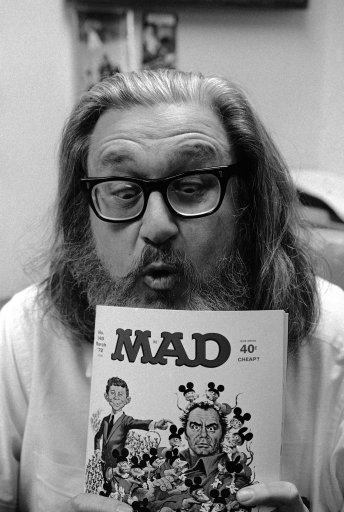
MAD publisher Bill Gaines, 1970.
MAD Magazine is an American institution. It’s been going since 1952 and is still funny, but it’s given the world more than just gags…
THE FREEDOM TO TAKE THE PISS
In 1961, a group of composers including Irving Berlin (writer of White Christmas) tried to sue MAD following a series of parody songs they’d published, to be sung to the tunes of the originals. The case ended up in the Supreme Court, which ultimately ruled in MAD’s favour – they basically ruled that it was clear these songs were jokes, that they weren’t intended to be mistaken for the originals, and that they weren’t damaging. This was seen as a landmark case in terms of making parodies legit, and is still regularly cited in courts.
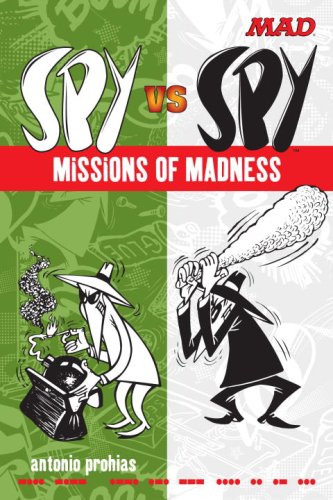
ULTRAVIOLENCE WITH A SUBTEXT
Antonio Prohias’s Spy Vs Spy strip was a wordless ongoing saga of a black-clad spy and a white-clad spy trapping, bombing, shooting and blowing each other up in contrived-but-amazing ways using good old-fashioned big round bombs with “BOMB” written on them. As well as needless violence, though, it’s an allegory of the Cold War, the thirty-year period of general global tenseness that led to the revolution in Prohias’s native Cuba. So it’s well clever, innit, with its explosions. Prohias died in 1998, but the strip continues in airbrush-and-stencil form by Peter Kuper, still bearing the credit “By Prohias” in spy-esque Morse Code every time.

A GAP-TOOTHED CHAMPION
The grinning, gap-toothed idiot on nearly every cover of MAD, Alfred E Neuman has become a beloved American icon despite rarely if ever showing up in the magazine itself – his appearances are limited to the cover and a quote on the contents page. On the covers, though, he’s been everyone from King Kong to Justin Bieber to Jabba The Hutt to the baby from the Nevermind album. He and his catchphrase (“What, me worry?”) have still become enormous – Jimi Hendrix introduced his Woodstock set with “What, me worry?”. Barack Obama, arguably the most powerful individual in the world, once described himself as having “the politics of [former Presidential candidate] Alfred E Smith and the ears of Alfred E Neuman”.
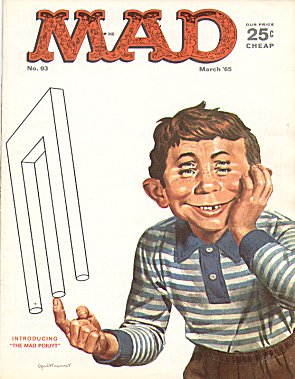
NEW FERSCHLUGGINER WORDS
You know that impossible-to-colour-in optical illusion of a trident that might be a bident? MAD named it – it’s called a poiuyt (which is a very satisfying word to type). They also enjoyed popularising obscure German or Yiddish words, like potrzebie, veeblefetzer and furshlugginer, which became ingrained enough in American culture to recently pop up in Boardwalk Empire.
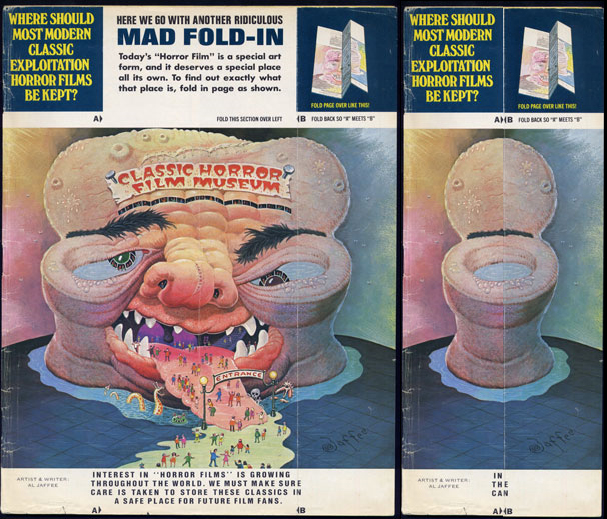
FOLD-INS
One of the trademark features of any issue of MAD is Al Jaffee’s Fold-In, an image on the inside back cover that starts off as one thing and, by folding a section of the page into another, reveals a hidden message – like the one Marge’s cellmate has tattooed on her back when she goes to prison in The Simpsons. They’re ridiculously clever, and the now 91-year-old Jaffee does them with no help from Photoshop or computers at all, preferring to paint on a stiff wooden board and only seeing the folded-in image when he’s sent the magazine. Try making one. You can’t. It’s just too HARD.
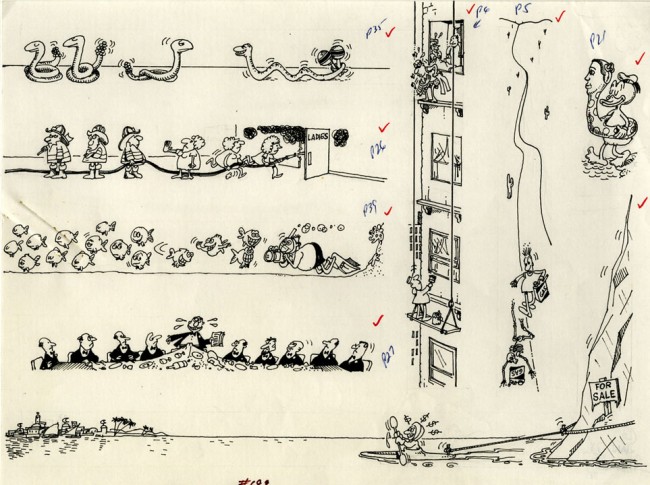
MARGINS BETTER THAN WHAT THEY SURROUNDED
Most magazines feature loads of dead space in the margins. At MAD they decided to make them a bit more interesting, by getting Sergio Aragones (owner of a badass moustache and known as the fastest cartoonist in the world) to doodle in them. He’s been doing this since 1963, only missing one issue when the Post Office lost his mail.
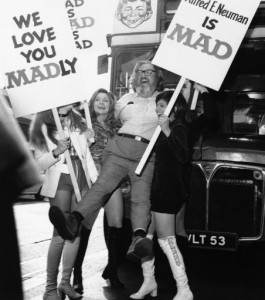
Bill Gaines being understated, London, 1971.
THE BEST PUBLISHER EVER
MAD founder Bill Gaines was the son of Max Gaines, who had been instrumental in the success of Action Comics in the 1930s before setting up his own company, Educational Comics (EC). After Max’s death, Bill took over and started publishing first romance, then horror comics. These comics – including Tales From The Crypt and Weird Science – were really successful but led to the Comics Code Authority, essentially a censorship board. Gaines responded by transforming the two-year-old MAD from a comic into a magazine. When MAD became successful, Gaines became known for his eccentricities and simultaneous cheapness and generosity. Every year he would take the whole staff on an overseas trip – one year, he found out MAD had one subscriber in Haiti, whose subscription was about to run out, so he took the whole staff to visit him and persuade him to renew it. He also once paid twice the market value of really low-grade paper because he felt MAD shouldn’t be printed on nice stock. Until his death in 1992, he was greeted by staff members with a cheery “Fuck you, Bill”.
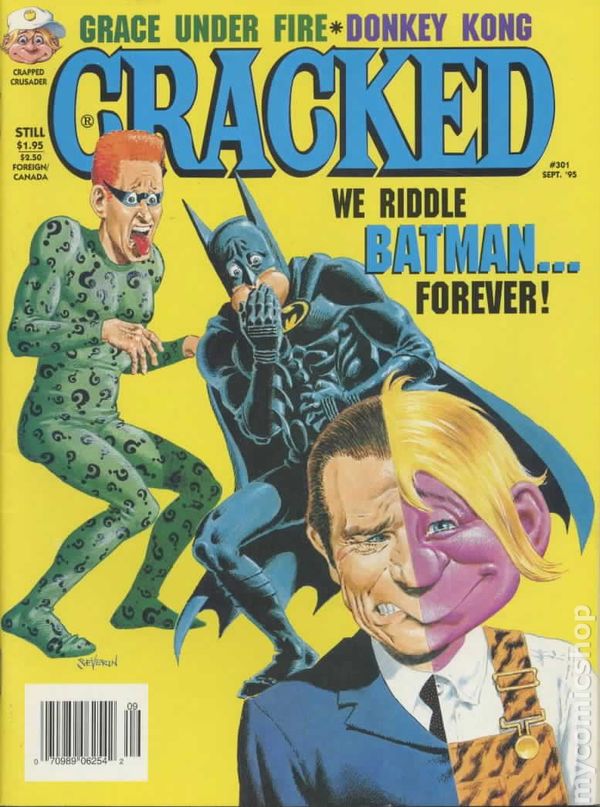
A BUNCH OF SHORT-LIVED IMITATORS
A lot of pretenders to MAD’s throne stepped up over the years, of varying degrees of quality. Cracked (which survives as the genuinely excellent Cracked.com) was an unabashed poor-man’s version of it that nonetheless lasted forty years, while Crazy, Sick, Flip, Whack, Nuts (not that one), Wild, Riot, Bughouse, Eh, Unsane, Get Lost and Panic all bit the dust pretty quick.
THE WORST MOVIE EVER
After the success of the amazing 1978 film Animal House, produced in association with the magazine National Lampoon, MAD became attached to a similar college-set film called Up The Academy, starring former Bond girl (and later wife of Ringo Starr) Barbara Bach. It was by all accounts a complete dog-egg, leading MAD to disown it, and Bill Gaines to pay $30,000 to remove MAD’s name from it and offer handwritten apologies and refunds to anyone who’d sat through it.
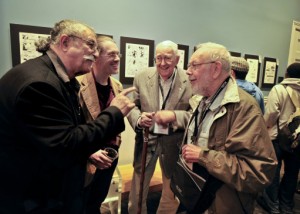
Mad Magazine cartoonist Sergio Aragones, left, Jack Davis and Al Jaffee, right, speak with Savannah College of Art and Design professor John Larison, second from the left, during an event hosted by SCAD and the National Cartoonists Society, Friday, Oct. 11, 2011 in Savannah, Ga.
THE USUAL GANG OF IDIOTS
Before the switch to magazine format, founding editor Harvey Kurtzman created the majority of the magazine, but after the switch, freelancers known as “the usual gang of idiots” came in and made the magazine their own. Regular readers of MAD learned to look out for certain names on features – if Dick DeBartolo had written a Mort Drucker-illustrated film spoof, you knew it was going to be good. One of their strangest but best-loved contributors was Don Martin, known for his incredibly unusual way of drawing feet and ridiculous sound effects – like Wonder Woman undoing her bra being soundtracked with “Snap ploobadoof”. Both loved and hated was Dave Berg’s The Lighter Side Of…, a long-running, severely inoffensive feature which featured probably the worst-dressed characters ever drawn.
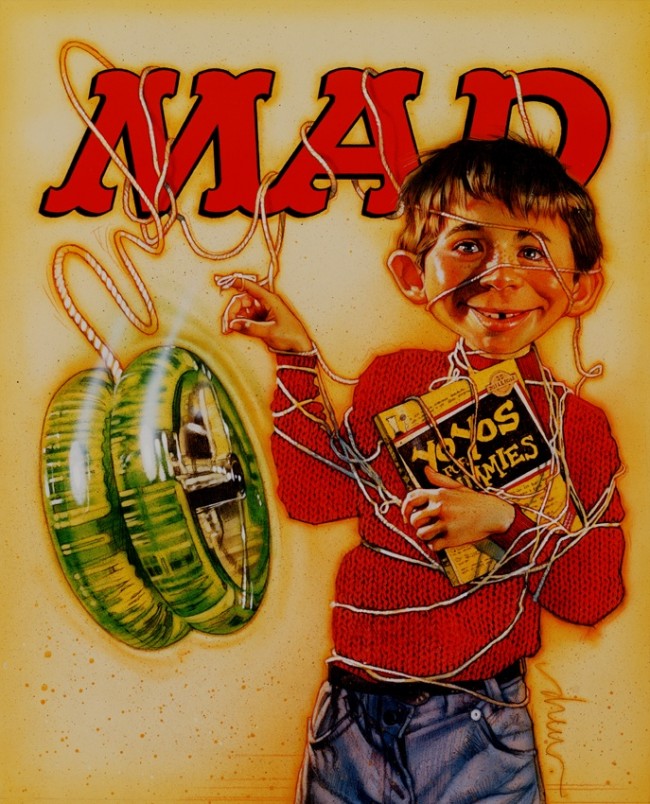
Cover by Drew Struzan.
BIG, BIG ART NAMES
As well as influencing a ton of big names (there’d be no Daniel Clowes without MAD, Robert Crumb cites it as a huge influence, and Alan Moore has claimed that MAD’s Superduperman spoof was a direct influence on Watchmen) some properly big deals have passed through the doors of MAD. Pulitzer Prize-winning cartoonist Art Spiegelman, of Maus fame, was a regular contributor, Drew Struzan and Frank Frazetta both did covers, and one issue a few years ago contained contributions from no less than ten Pulitzer-winning cartoonists. Plus “Weird Al” Yankovic once wrote for them.
A BETTER VIZ
Viz editor Graham Dury, creator of the Fat Slags, tells us “MAD magazine had a massive influence on me when I was little. The two blokes on earth I would most like to get stuck in a lift with are Don Martin and Sergio Aragones, so long as they had a big stack of paper and some pens with them. I loved the way everybody Martin drew had that fantastic self-confident strut and shoes that flopped over at the end. And Aragones’s scribblings were probably the best bit of the magazine. They showed that the editors really cared about it and wanted to just pack it with stuff. But I doubt I’ll end up in a lift with either of them. Well certainly not Don Martin anyway, as he’s dead. If any of your readers see Sergio Aragones getting into a dodgy looking lift, could they let me know?”
SUPER-CHUFFED CELEBS
Much in the same way that Nirvana only really felt like they’d made it when they got a call from “Weird Al” Yankovic, being spoofed in MAD is kind of like a badge of honour. MAD’s letters page regularly features notes from celebrities proudly holding up magazines taking the piss out of them. When asked about big moments in his career, Slash from Guns N’Roses said “The magazine cover that has meant the most to me was probably when I appeared in MAD magazine, as a caricature of Alfred E. Neuman. That was when I felt I’d arrived.”
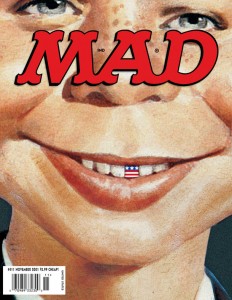
AMERICA IN A NUTSHELL
If there was an alien race out there that had only ever been exposed to MAD, they’d have a pretty decent grasp of modern American history. You can trace wars, leaders, politics and technology through it, as well as the history of entertainment, from issue #4’s Superduperman to last issue’s Robin Thicke and Miley Cyrus cover. MAD’s first cover after 9/11 nearly didn’t happen – the initial cover story was on the New York Marathon, and showed corpse-laden NY streets. They wisely decided to pull it, and replaced it with an image that was simultaneously funny, respectful, patriotic and… excuse us, there must be dust in here.
HEALTHY CYNICISM
Comics in the 50s didn’t encourage people to question anything – everything was more about being pleasant and not rocking the boat. MAD came along and started picking holes in the American Dream, suggesting the products Americans were buying were crap, their leaders were clueless and that the people were being treated like dicks. These days everyone’s a cynical bastard, but MAD invented it.
Posted: 5th, March 2014 | In: Books, Key Posts, Reviews Comments (2) | TrackBack | Permalink


